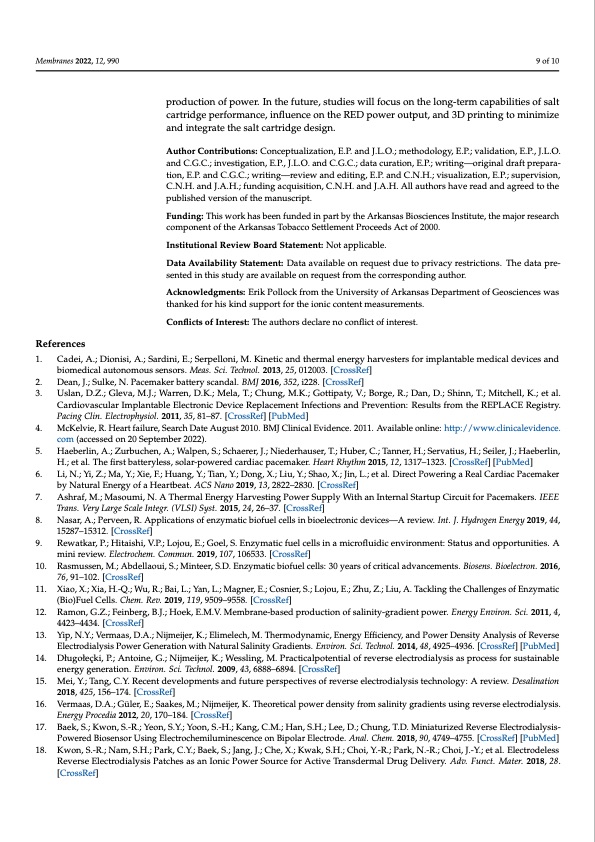
PDF Publication Title:
Text from PDF Page: 009
Membranes 2022, 12, 990 9 of 10 References production of power. In the future, studies will focus on the long-term capabilities of salt cartridge performance, influence on the RED power output, and 3D printing to minimize and integrate the salt cartridge design. Author Contributions: Conceptualization, E.P. and J.L.O.; methodology, E.P.; validation, E.P., J.L.O. and C.G.C.; investigation, E.P., J.L.O. and C.G.C.; data curation, E.P.; writing—original draft prepara- tion, E.P. and C.G.C.; writing—review and editing, E.P. and C.N.H.; visualization, E.P.; supervision, C.N.H. and J.A.H.; funding acquisition, C.N.H. and J.A.H. All authors have read and agreed to the published version of the manuscript. Funding: This work has been funded in part by the Arkansas Biosciences Institute, the major research component of the Arkansas Tobacco Settlement Proceeds Act of 2000. Institutional Review Board Statement: Not applicable. Data Availability Statement: Data available on request due to privacy restrictions. The data pre- sented in this study are available on request from the corresponding author. Acknowledgments: Erik Pollock from the University of Arkansas Department of Geosciences was thanked for his kind support for the ionic content measurements. Conflicts of Interest: The authors declare no conflict of interest. 1. Cadei, A.; Dionisi, A.; Sardini, E.; Serpelloni, M. Kinetic and thermal energy harvesters for implantable medical devices and biomedical autonomous sensors. Meas. Sci. Technol. 2013, 25, 012003. [CrossRef] 2. Dean, J.; Sulke, N. Pacemaker battery scandal. BMJ 2016, 352, i228. [CrossRef] 3. Uslan, D.Z.; Gleva, M.J.; Warren, D.K.; Mela, T.; Chung, M.K.; Gottipaty, V.; Borge, R.; Dan, D.; Shinn, T.; Mitchell, K.; et al. Cardiovascular Implantable Electronic Device Replacement Infections and Prevention: Results from the REPLACE Registry. Pacing Clin. Electrophysiol. 2011, 35, 81–87. [CrossRef] [PubMed] 4. McKelvie, R. Heart failure, Search Date August 2010. BMJ Clinical Evidence. 2011. Available online: http://www.clinicalevidence. com (accessed on 20 September 2022). 5. Haeberlin, A.; Zurbuchen, A.; Walpen, S.; Schaerer, J.; Niederhauser, T.; Huber, C.; Tanner, H.; Servatius, H.; Seiler, J.; Haeberlin, H.; et al. The first batteryless, solar-powered cardiac pacemaker. Heart Rhythm 2015, 12, 1317–1323. [CrossRef] [PubMed] 6. Li, N.; Yi, Z.; Ma, Y.; Xie, F.; Huang, Y.; Tian, Y.; Dong, X.; Liu, Y.; Shao, X.; Jin, L.; et al. Direct Powering a Real Cardiac Pacemaker by Natural Energy of a Heartbeat. ACS Nano 2019, 13, 2822–2830. [CrossRef] 7. Ashraf, M.; Masoumi, N. A Thermal Energy Harvesting Power Supply With an Internal Startup Circuit for Pacemakers. IEEE Trans. Very Large Scale Integr. (VLSI) Syst. 2015, 24, 26–37. [CrossRef] 8. Nasar, A.; Perveen, R. Applications of enzymatic biofuel cells in bioelectronic devices—A review. Int. J. Hydrogen Energy 2019, 44, 15287–15312. [CrossRef] 9. Rewatkar, P.; Hitaishi, V.P.; Lojou, E.; Goel, S. Enzymatic fuel cells in a microfluidic environment: Status and opportunities. A mini review. Electrochem. Commun. 2019, 107, 106533. [CrossRef] 10. Rasmussen, M.; Abdellaoui, S.; Minteer, S.D. Enzymatic biofuel cells: 30 years of critical advancements. Biosens. Bioelectron. 2016, 76, 91–102. [CrossRef] 11. Xiao, X.; Xia, H.-Q.; Wu, R.; Bai, L.; Yan, L.; Magner, E.; Cosnier, S.; Lojou, E.; Zhu, Z.; Liu, A. Tackling the Challenges of Enzymatic (Bio)Fuel Cells. Chem. Rev. 2019, 119, 9509–9558. [CrossRef] 12. Ramon, G.Z.; Feinberg, B.J.; Hoek, E.M.V. Membrane-based production of salinity-gradient power. Energy Environ. Sci. 2011, 4, 4423–4434. [CrossRef] 13. Yip, N.Y.; Vermaas, D.A.; Nijmeijer, K.; Elimelech, M. Thermodynamic, Energy Efficiency, and Power Density Analysis of Reverse Electrodialysis Power Generation with Natural Salinity Gradients. Environ. Sci. Technol. 2014, 48, 4925–4936. [CrossRef] [PubMed] 14. Długołeçki, P.; Antoine, G.; Nijmeijer, K.; Wessling, M. Practicalpotential of reverse electrodialysis as process for sustainable energy generation. Environ. Sci. Technol. 2009, 43, 6888–6894. [CrossRef] 15. Mei, Y.; Tang, C.Y. Recent developments and future perspectives of reverse electrodialysis technology: A review. Desalination 2018, 425, 156–174. [CrossRef] 16. Vermaas, D.A.; Güler, E.; Saakes, M.; Nijmeijer, K. Theoretical power density from salinity gradients using reverse electrodialysis. Energy Procedia 2012, 20, 170–184. [CrossRef] 17. Baek, S.; Kwon, S.-R.; Yeon, S.Y.; Yoon, S.-H.; Kang, C.M.; Han, S.H.; Lee, D.; Chung, T.D. Miniaturized Reverse Electrodialysis- Powered Biosensor Using Electrochemiluminescence on Bipolar Electrode. Anal. Chem. 2018, 90, 4749–4755. [CrossRef] [PubMed] 18. Kwon, S.-R.; Nam, S.H.; Park, C.Y.; Baek, S.; Jang, J.; Che, X.; Kwak, S.H.; Choi, Y.-R.; Park, N.-R.; Choi, J.-Y.; et al. Electrodeless Reverse Electrodialysis Patches as an Ionic Power Source for Active Transdermal Drug Delivery. Adv. Funct. Mater. 2018, 28. [CrossRef]PDF Image | Integrated Salt Cartridge-Reverse Electrodialysis

PDF Search Title:
Integrated Salt Cartridge-Reverse ElectrodialysisOriginal File Name Searched:
membranes-12-00990.pdfDIY PDF Search: Google It | Yahoo | Bing
Product and Development Focus for Salgenx
Redox Flow Battery Technology: With the advent of the new USA tax credits for producing and selling batteries ($35/kW) we are focussing on a simple flow battery using shipping containers as the modular electrolyte storage units with tax credits up to $140,000 per system. Our main focus is on the salt battery. This battery can be used for both thermal and electrical storage applications. We call it the Cogeneration Battery or Cogen Battery. One project is converting salt (brine) based water conditioners to simultaneously produce power. In addition, there are many opportunities to extract Lithium from brine (salt lakes, groundwater, and producer water).Salt water or brine are huge sources for lithium. Most of the worlds lithium is acquired from a brine source. It's even in seawater in a low concentration. Brine is also a byproduct of huge powerplants, which can now use that as an electrolyte and a huge flow battery (which allows storage at the source).We welcome any business and equipment inquiries, as well as licensing our flow battery manufacturing.| CONTACT TEL: 608-238-6001 Email: greg@salgenx.com | RSS | AMP |